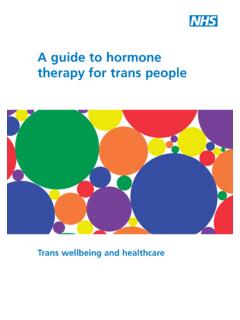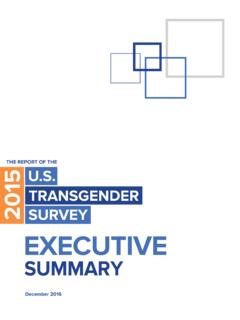Transcription of Guidelines for Psychological Practice With Transgender and ...
1 Guidelines for Psychological Practice WithTransgender and Gender Nonconforming PeopleAmerican Psychological AssociationTransgender and gender nonconforming1(TGNC) peopleare those who have a gender identity that is not fullyaligned with their sex assigned at birth. The existence ofTGNC people has been documented in a range of historicalcultures (Coleman, Colgan, & Gooren, 1992; Feinberg,1996;Miller & Nichols, 2012; Schmidt, 2003). Currentpopulation estimates of TGNC people have ranged to 1,333 per 100,000 (Meier & Labuski, 2013). TheMassachusetts Behavioral Risk Factor Surveillance Surveyfound of the adult population aged 18 to 64 yearsidentified as TGNC between 2009 and 2011 (Conron,Scott, Stowell, & Landers, 2012). However, populationestimates likely underreport the true number of TGNC people , given difficulties in collecting comprehensive de-mographic information about this group (Meier & Labuski,2013).
2 Within the last two decades, there has been a sig-nificant increase in research about TGNC people . Thisincrease in knowledge, informed by the TGNC community,has resulted in the development of progressively moretrans-affirmative Practice across the multiple health disci-plines involved in the care of TGNC people (Bockting,Knudson, & Goldberg, 2006; Coleman et al., 2012). Re-search has documented the extensive experiences of stigmaand discrimination reported by TGNC people (Grant et al.,2011) and the mental health consequences of these expe-riences across the life span (Bockting, Miner, SwinburneRomine, Hamilton, & Coleman, 2013), including increasedrates of depression (Fredriksen-Goldsen et al., 2014) andsuicidality (Clements-Nolle, Marx, & Katz, 2006).
3 TGNC people s lack of access to trans -affirmative mental andphysical health care is a common barrier (Fredriksen-Gold-sen et al., 2014;Garofalo, Deleon, Osmer, Doll, & Harper,2006;Grossman & D Augelli, 2006), with TGNC peoplesometimes being denied care because of their gender iden-tity (Xavier et al., 2012).In 2009, the American Psychological Association(APA) Task Force on Gender Identity and Gender Variance(TFGIGV) survey found that less than 30% of psychologistand graduate student participants reported familiarity withissues that TGNC people experience (APA TFGIGV,2009). Psychologists and other mental health professionalswho have limited training and experience in TGNC-affir-mative care may cause harm to TGNC people (Mikalson,Pardo, & Green, 2012; Xavier et al.)
4 , 2012). The significantlevel of societal stigma and discrimination that TGNC people face, the associated mental health consequences,and psychologists lack of familiarity with trans -affirmativecare led the APA Task Force to recommend that psycho-logical Practice Guidelines be developed to help psycholo-gists maximize the effectiveness of services offered andavoid harm when working with TGNC people and purpose of theGuidelines for Psychological Practicewith Transgender and Gender Nonconforming people (hereafterGuidelines) is to assist psychologists in the pro-vision of culturally competent, developmentally appropri-ate, and trans -affirmative Psychological Practice withTGNC people . trans -affirmative Practice is the provisionThe American Psychological Association s (APA s) Task Force onGuidelines for Psychological Practice with Transgender and Gender Non-conforming people developed these Guidelines .
5 Lore m. dickey, LouisianaTech University, and Anneliese A. Singh, The University of Georgia,served as chairs of the Task Force. The members of the Task Forceincluded Walter O. Bockting, Columbia University; Sand Chang, Inde-pendent Practice ; Kelly Ducheny, Howard Brown Health Center; LauraEdwards-Leeper, Pacific University; Randall D. Ehrbar, Whitman WalkerHealth Center; Max Fuentes Fuhrmann, Independent Practice ; Michael , Washington Psychological Center, ; and Ellen Magalhaes,Center for Psychological Studies at Nova Southeastern University andCalifornia School of Professional Psychology at Alliant Task Force is grateful to BT, Robin Buhrke, Jenn Burleton, TheoBurnes, Loree Cook-Daniels, Ed Delgado-Romero, Maddie Deutsch, Mi-chelle Emerick, Terry S.
6 Gock, Kristin Hancock, Razia Kosi, KimberlyLux, Shawn MacDonald, Pat Magee, Tracee McDaniel, Edgardo Men-vielle, Parrish Paul, Jamie Roberts, Louise Silverstein, Mary Alice Sil-verman, Holiday Simmons, Michael C. Smith, Cullen Sprague, DavidWhitcomb, and Milo Wilson for their assistance in providing importantinput and feedback on drafts of the Guidelines . The Task Force is espe-cially grateful to Clinton Anderson, Director, and Ron Schlittler, ProgramCoordinator, of APA s Office on LGBT Concerns, who adeptly assistedand provided counsel to the Task Force throughout this project. The TaskForce would also like to thank liaisons from the APA Committee onProfessional Practice and Standards (COPPS), April Harris-Britt and ScottHunter, and their staff support, Mary Hardiman.
7 Additionally, members ofthe Task Force would like to thank the staff at the Phillip Rush Center andAgnes Scott College Counseling Center in Atlanta, Georgia, who servedas hosts for face-to-face document will expire as APA policy in 2022. After this date,users should contact the APA Public Interest Directorate to determinewhether the Guidelines in this document remain in effect as APA concerning this article should be addressed to thePublic Interest Directorate, American Psychological Association, 750 First Street, NE, Washington, DC the purposes of these Guidelines , we use the termtransgenderand gender nonconforming(TGNC). We intend for the term to be asbroadly inclusive as possible, and recognize that some TGNC people donot ascribe to these terms.
8 Readers are referred toAppendix Afor a listingof terms that include various TGNC identity document is copyrighted by the American Psychological Association or one of its allied article is intended solely for the personal use of the individual user and is not to be disseminated 2015 American Psychologist 2015 American Psychological Association 0003-066X/15/$ 70, No. 9, 832 864 care that is respectful, aware, and supportive of theidentities and life experiences of TGNC people (Korell &Lorah, 2007). TheGuidelinesare an introductory resourcefor psychologists who will encounter TGNC people in theirpractice, but can also be useful for psychologists withexpertise in this area of Practice to improve the care alreadyoffered to TGNC people . TheGuidelinesinclude a set ofdefinitions for readers who may be less familiar with lan-guage used when discussing gender identity and TGNC populations (seeAppendix A).
9 Distinct from TGNC, theterm cisgender is used to refer to people whose sexassigned at birth is aligned with their gender identity (E. , 2006;Serano, 2006).Given the added complexity of working with TGNCand gender-questioning youth2and the limitations of theavailable research, theGuidelinesfocus primarily, thoughnot exclusively, on TGNC adults. Future revisions of theGuidelineswill deepen a focus on TGNC and gender-questioning children and adolescents. TheGuidelinesad-dress the strengths of TGNC people , the challenges theyface, ethical and legal issues, life span considerations,research, education, training, and health care. Because is-sues of gender identity are often conflated with issues ofgender expression or sexual orientation, psychologicalpractice with the TGNC population warrants the acquisi-tion of specific knowledge about concerns unique to TGNC people that are not addressed by other Practice Guidelines (APA, 2012).
10 It is important to note that theseGuidelinesare not intended to address some of the conflicts thatcisgender people may experience due to societal expecta-tions regarding gender roles (Butler, 1990), nor are theyintended to address intersex people (Dreger, 1999;Preves,2003).Documentation of NeedIn 2005, the APA Council of Representatives authorizedthe creation of the Task Force on Gender Identity andGender Variance (TFGIGV), charging the Task Force toreview APA policies related to TGNC people and to offerrecommendations for APA to best meet the needs of TGNC people (APA TFGIGV, 2009). In 2009, the APA Councilof Representatives adopted the Resolution on Transgender ,Gender Identity, & Gender Expression Non-Discrimina-tion, which calls upon psychologists in their professionalroles to provide appropriate, nondiscriminatory treatment;encourages psychologists to take a leadership role in work-ing against discrimination; supports the provision of ade-quate and necessary mental and medical health care; rec-ognizes the efficacy, benefit, and medical necessity ofgender transition; supports access to appropriate treatmentin institutional settings; and supports the creation of edu-cational resources for all psychologists (Anton, 2009).














